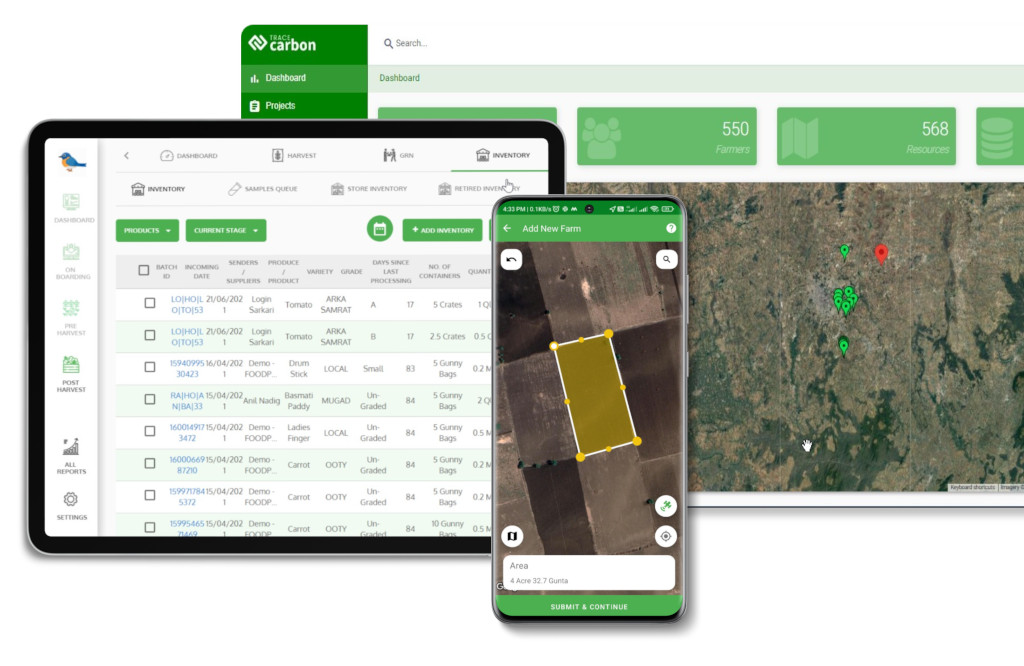Contact: +91 99725 24322 |
Menu
Menu
Quick summary: Discover what the EUDR system means for your business and how to stay compliant with EU deforestation-free regulations. Learn key steps, tools, and timelines for traceability and due diligence.

The EU Deforestation Regulation (EUDR) system is a legal framework (Regulation EU 2023/1115) designed to ensure that certain commodities—like coffee, cocoa, palm oil, soy, cattle, rubber, and wood—sold in the EU are not linked to deforestation post-December 31, 2020. Businesses must prove products are deforestation-free, legally sourced, and geolocated through a Due Diligence Statement (DDS) submitted to the EU Information System. Non-compliance may lead to market exclusion and penalties. To stay compliant, businesses should digitize supplier onboarding, implement geo-mapping, and adopt traceability platforms.
As global demand for sustainable sourcing rises, the EU Deforestation Regulation (EUDR)—formally known as Regulation (EU) 2023/1115—has become a critical checkpoint for businesses trading in high-risk commodities like coffee, cocoa, soy, palm oil, wood, cattle, and rubber. At its core, EUDR mandates that products placed on or exported from the EU market must be deforestation-free (i.e., not linked to land deforested after December 31, 2020) and legally produced in accordance with the source country’s laws.
But EUDR goes beyond environmental protection. It offers a competitive edge—enabling market access, building buyer trust, and setting a compliance benchmark for traceability and sustainability. Companies that understand and adapt to this regulation stand to gain early mover advantages in increasingly climate-conscious EU markets.
But EUDR goes beyond environmental protection. It offers a competitive edge—enabling market access, building buyer trust, and setting a compliance benchmark for traceability and sustainability. Companies that understand and adapt to this regulation stand to gain early mover advantages in increasingly climate-conscious EU markets.
Key Takeaways
The EUDR (EU Deforestation Regulation), formally known as Regulation (EU) 2023/1115, is a landmark policy by the European Commission that aims to eliminate deforestation-linked products from entering the EU market. Unlike earlier sustainability frameworks, EUDR enforces legal obligations on supply chain actors to ensure that commodities are “deforestation-free” post-December 31, 2020, and legally produced according to local environmental and land-use laws.
“Deforestation-free” means no land used to grow, raise, or extract relevant commodities was cleared of forests after this cutoff date—regardless of whether the land use change was legal in the origin country. This approach reflects a zero-tolerance stance toward forest loss as part of climate and biodiversity goals.
What sets the EUDR apart is its geolocation requirement—every batch must be traceable to the plot of land it was sourced from. This introduces a data-driven layer of transparency that blends ESG goals with actionable compliance systems. For businesses, it’s not just about legality but operational credibility—a shift from paper-based to plot-based accountability.
The EUDR rollout timeline is intentionally tiered to allow stakeholders time to align operations:
This phased approach reflects the EU’s recognition of varying resource capabilities, while still reinforcing that deforestation-free sourcing is non-negotiable for market access.
One of the most transformative elements of the EUDR is the planned risk benchmarking system. The EU has classified countries into low-, standard-, or high-risk categories based on deforestation rates, governance, and enforcement.
This framework signals a shift from blanket regulation to data-driven, risk-adjusted governance. It empowers responsible sourcing from compliant regions while pressuring high-risk geographies to strengthen environmental safeguards.
For businesses, this creates both a compliance incentive and a market opportunity: sourcing from low-risk countries may soon be a competitive advantage.
Complying with EUDR isn’t just about documentation—it’s about operational transparency from ground to EU border.
Businesses must collect precise geolocation data for every plot used to produce relevant commodities—either as point coordinates or detailed polygons. This ensures the product’s origin can be validated as not contributing to deforestation post-2020.
Think of geolocation as your “digital land passport.” It transforms farmland into verifiable assets, critical for both compliance and investor ESG confidence.
The DDS is a mandatory declaration businesses must submit to EU authorities before placing goods on the market. It confirms that products are deforestation-free, legally sourced, and risk-assessed.
You must show that the land was legally cleared, cultivated, and used, aligned with local laws of the production country. This adds a jurisdiction-specific compliance layer.
The EUDR raises the bar beyond sustainability—it fuses environmental protection with legal traceability, unlike any previous regulation.
Each operator must assess supply chain risk based on:
All DDS and associated documents must be submitted via EU TRACES, a centralized digital portal. Expect integration with digital traceability platforms to streamline uploads, status tracking, and EU authority interactions.
Explore our blog on,
Geolocation best practices
Digital Traceability for EUDR
EUDR compliance isn’t just a documentation exercise—it’s a data-driven transformation of agri-supply chains. Digital technologies make it possible to move from manual, fragmented reporting to continuous, verifiable traceability at scale.
Modern traceability platforms like TraceX, enable procurement teams to onboard suppliers digitally—capturing KYC, land documents, input records, and farm practices with secure, multilingual workflows.
This turns supplier engagement into an opportunity, not a bottleneck—faster onboarding = faster compliance = faster market access.
Tools powered by GeoJSON formats, satellite APIs (like Sentinel or Planet), and Agentic AIs help businesses generate deforestation risk profiles per plot. These tools ensure each DDS is backed by spatial evidence.
Satellite-verified compliance is now a proof point for audits, not just a nice-to-have. It’s also vital for smallholder-heavy supply chains where paperwork is inconsistent.
Cloud-based dashboards consolidate:
This provides compliance, sustainability, and procurement teams with shared visibility, improving audit preparedness.
Best-in-class platforms offer automated export to the EU’s TRACES system, plus integration with:
Compliance is converging. One data stream can now serve multiple sustainability laws—saving time, reducing duplication, and unlocking multi-regulation ROI.
Meeting EUDR system requirements isn’t just about ticking regulatory boxes—it’s about restructuring your supply chain around verifiable, geospatial, and legally sound data. And most agri-exporters aren’t fully prepared for the shift.
In most agri-value chains, supplier information is scattered across spreadsheets, emails, WhatsApp messages, and siloed ERPs. This leads to:
Compliance failure often isn’t due to negligence—but data fragmentation at scale. Businesses need a centralized, digital supplier master to meet EUDR due diligence thresholds.
EUDR mandates geolocation data (plot boundaries or points). Many exporters rely on hand-drawn maps, GPS screenshots, or outdated land surveys.
Plot-level compliance = plot-level precision. Without consistent GeoJSON or polygon data, your DDS could be flagged—especially for high-risk regions.
Most operators lack automated workflows to create, update, or submit DDS for each consignment. Manually filling forms, cross-checking files, or handling TRACES uploads results in:
Businesses that automate DDS generation tied to procurement events gain speed, accuracy, and audit-readiness—a critical competitive edge.
In regions with smallholder-heavy supply chains (like India, Ghana, or Indonesia), farmers may lack:
Compliance must be inclusive. Without investments in digital onboarding, mobile tools, and field agent training, smallholders will be unintentionally excluded—hurting both equity and volume.
To succeed under the EUDR system, businesses must shift from fragmented, manual compliance efforts to digitally unified, real-time data systems—designed with both legal and smallholder realities in mind.
Navigating the EU Deforestation Regulation (EUDR) requires more than basic compliance—it demands a systematic, digital-first strategy that integrates supply chain traceability, legal assurance, and automated documentation. Here’s how businesses can achieve it:

Start by identifying whether you’re a large operator (deadline: Dec 30, 2025) or SME (June 30, 2026). Then review your sourcing countries’ risk status—high-risk countries require stricter due diligence.
Use benchmarking not just to meet compliance timelines, but to prioritize onboarding regions and suppliers proactively.
Digitally onboard suppliers with:
Think of onboarding as building a “regulatory passport“ for each supplier—one that can travel across EUDR, FSC, or organic certifications.
Use satellite datasets (like Hansen GFC or Sentinel-2) to check deforestation since 2020. Validate:
Legal nuance differs by country. Partner with local experts or integrate national land databases where available.
Centralize:
Use a platform aligned with EUDR or FSC’s Information System standards.
This step future-proofs your compliance for Digital Product Passports, expected under the EU’s broader sustainability framework.
Create a Due Diligence Statement (DDS) for each shipment:
Automate DDS generation and submission using rule-based workflows triggered by procurement or export events.
Stay updated on EU’s country benchmarking. Shift suppliers or mitigation measures if risk scores rise.
Maintain versioned compliance records for:
Dynamic compliance = real-time adaptability. This is essential as regulations tighten or expand (e.g., to financial disclosures or biodiversity).
A step-by-step EUDR compliance roadmap isn’t static—it must evolve with regulatory updates, supply shifts, and digital capabilities. Businesses that embed traceability, automation, and transparency at each step will not only comply—but gain strategic sourcing advantage in the EU market.
The EU Deforestation Regulation (EUDR) is not just another environmental rule—it’s a transformative trade barrier that rewards businesses with foresight and penalizes those that delay. Acting now isn’t optional; it’s strategic.
Non-compliance after the EUDR enforcement dates (Dec 30, 2025 for large operators, June 30, 2026 for SMEs) can result in:
Traceability isn’t just for auditors—it’s your customs clearance passport.
Early adopters of deforestation-free sourcing will:
Compliance becomes a brand story—especially in sectors like coffee, cocoa, and timber where consumer scrutiny is high.
Beyond EUDR, the same digital due diligence systems can prepare you for:
Companies that digitize supply chains today will lead tomorrow’s climate-smart, regulation-ready trade networks.
Navigating the complexities of the EU Deforestation Regulation (EUDR) demands more than spreadsheets and emails—it requires a digitally integrated compliance strategy. TraceX’s EUDR-focused traceability platform empowers businesses with the tools to meet, manage, and scale their compliance obligations across complex supply chains.
TraceX simplifies EUDR requirements by digitizing every step of the process—from supplier onboarding to Due Diligence Statement (DDS) submission. This minimizes manual errors, reduces lead times, and ensures that all data is audit-ready.
The platform enables field teams to onboard suppliers with GPS-verified plot boundaries (points or polygons), KYC documentation, and land-use declarations—aligned with EUDR’s geo-location and legality requirements.
See How Cocoa Traceability Works on the Ground
Explore how farm-level mapping enabled deforestation-free cocoa sourcing in Nigeria.
Read the full case study now and discover how your supply chain can stay EUDR-compliant with real-time farm data.
TraceX uses rule engines mapped to EUDR Article 9 to auto-generate DDS forms based on plot location, commodity, supplier risk score, and legal documentation. This ensures accurate and timely submissions through TRACES.
Seamlessly integrate DDS uploads and supporting documents (land tenure, geoJSON files, crop proof) with EU TRACES or local CAs (Competent Authorities) via API-ready workflows. Maintain version control, time-stamped logs, and digital audit trails.
TraceX uses satellite overlays and regional deforestation datasets (e.g., Hansen GFC, Sentinel-2) to assign plot-level deforestation and legal risk scores. When risk thresholds are breached, the system triggers mitigation workflows: supplier escalation, gap alerts, or legal team review.
The EUDR system isn’t just another regulation—it’s a catalyst for transforming how supply chains operate. By adopting digital tools, establishing plot-level traceability, and embedding due diligence into supplier workflows, businesses can not only meet EUDR requirements but lead in sustainable sourcing. Early compliance enables smoother audits, future-proofs market access, and builds trust with EU buyers who increasingly prioritize transparency. The smartest businesses won’t wait for deadlines—they’ll use this moment to lead with integrity and innovation.
The EUDR (EU Deforestation Regulation) is a regulation (EU 2023/1115) requiring that certain commodities and their derived products—such as coffee, cocoa, soy, palm oil, rubber, wood, and cattle—entering or leaving the EU are deforestation-free and legally produced post-December 31, 2020.
Operators and traders placing these goods on the EU market or exporting them from the EU must comply, regardless of size, with SMEs receiving an extended deadline (June 2026)
To generate a Due Diligence Statement (DDS), businesses must:
Businesses can leverage digital traceability platforms for:
